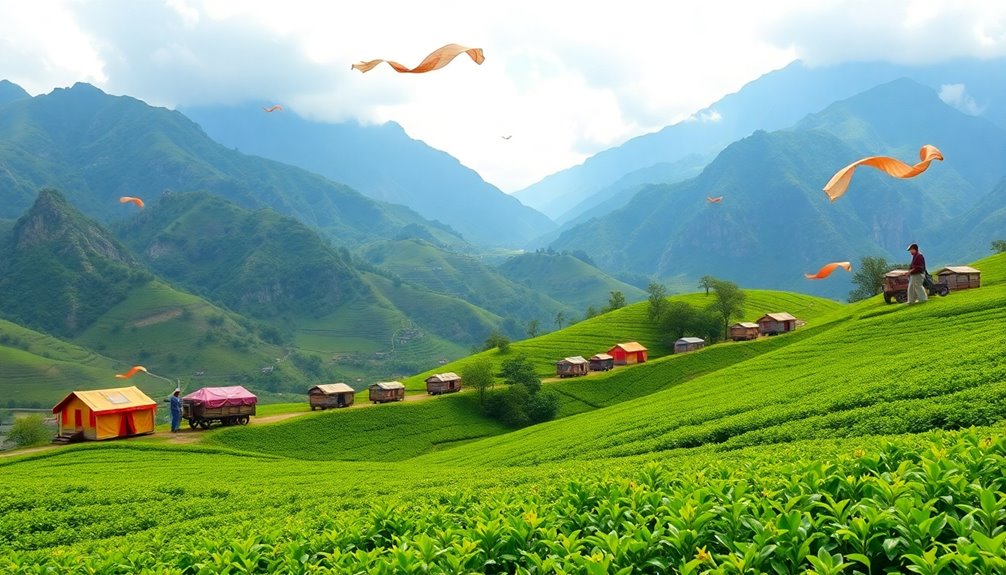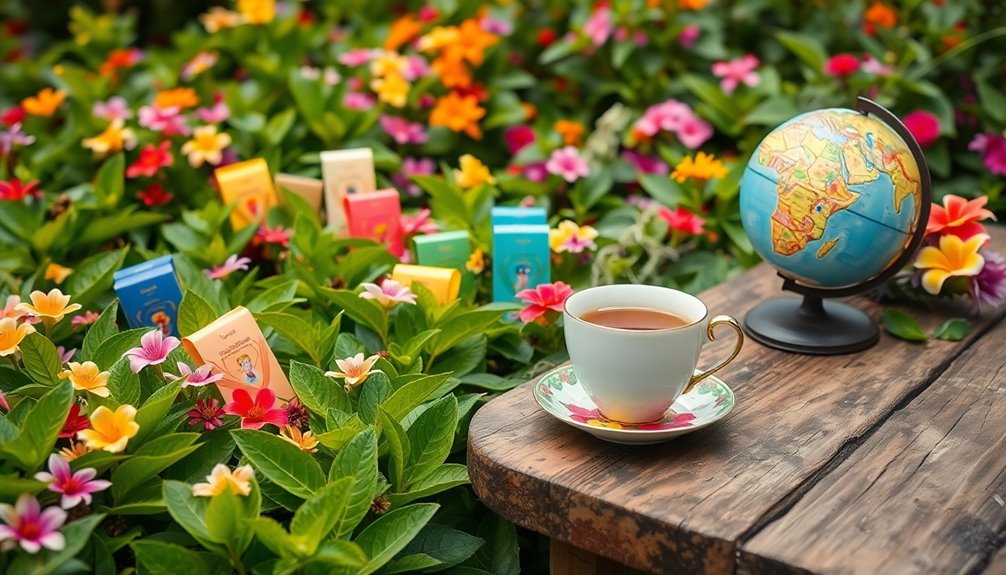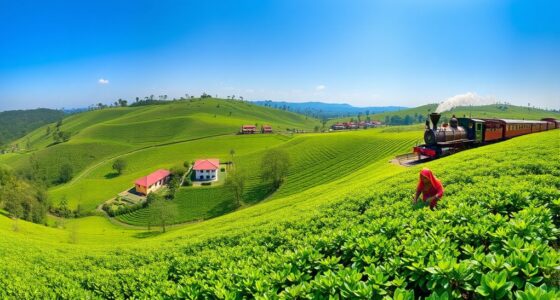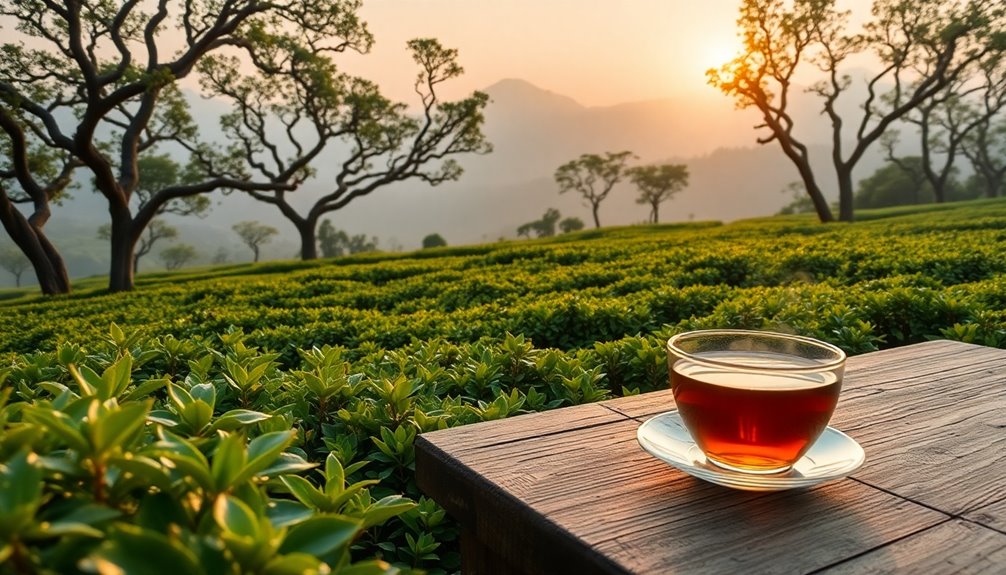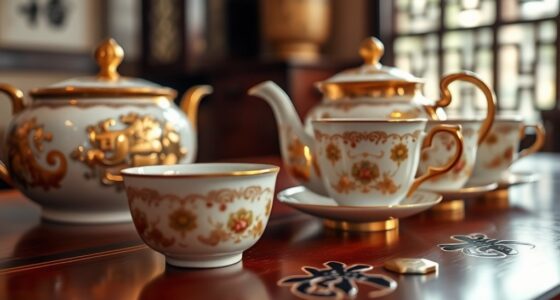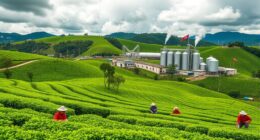The secret tea trails of the Silk Road hold fascinating stories about how tea traveled and transformed cultures. Beginning in ancient China, tea spread through trade routes to lands far and wide, becoming a symbol of hospitality and social customs. You might be surprised to learn about unique tea preparation methods from various regions, like Japanese ceremonies or Moroccan mint tea. Lesser-known areas like Yunnan and Dali boasted distinct flavors, enriching this beverage's heritage. As you explore, you'll discover how tea influences cultures today, hinting at even more captivating stories waiting to be uncovered along these historic paths.
Key Takeaways
- The Silk Road facilitated the exchange of tea culture, connecting China with trade partners across Asia and Europe.
- Tea was a vital commodity along the Silk Road, influencing economic relationships and cultural exchanges among various regions.
- The Tea Horse Road, a crucial branch of the Silk Road, enabled the trade of tea and goods between Yunnan, Tibet, and India.
- Unique tea varieties and preparation methods thrived along the Silk Road, enriching cultural traditions and practices.
- Lesser-known tea-producing regions like Yunnan, Dali, and Shaxi contributed to the diverse tea landscape and historical significance of the Silk Road.
Introduction
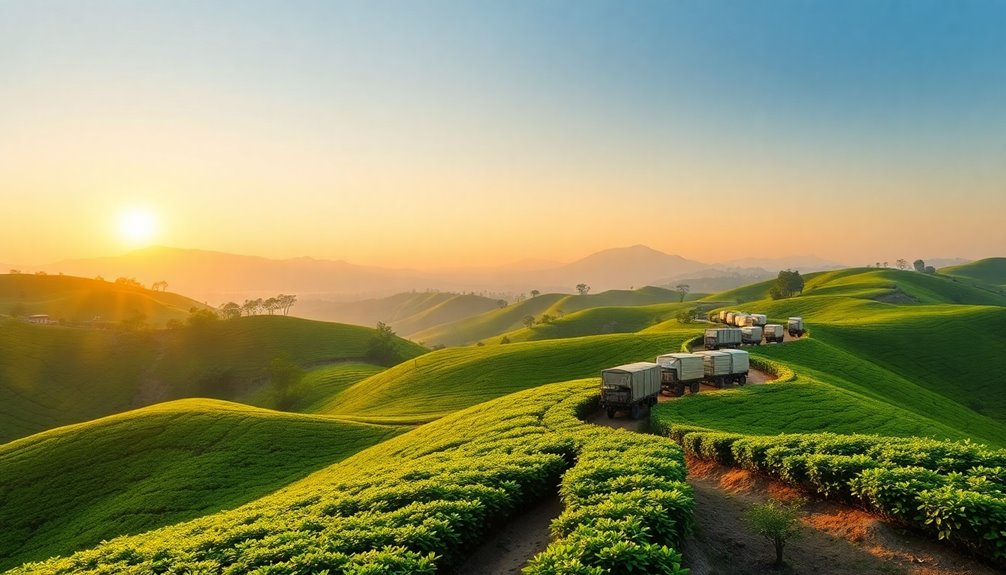
The Silk Road, a remarkable network of trade routes, not only connected distant lands but also transformed cultures through the exchange of goods like tea. This fascinating journey began in the Yunnan province of China, where tea first emerged. Over time, the tea trade flourished, especially during the Tang Dynasty, when tea became a beloved drink for many.
As you explore these ancient trade routes, you'll discover how tea made its way to Central Asian regions, becoming an essential part of daily life and hospitality. The Tea Horse Road, a vital branch of the Silk Road, connected Yunnan to Tibet and India, allowing merchants to exchange tea for horses and spices.
Towns like Dali and Lijiang became crucial hubs for tea processing, where unique varieties, such as raw puer, are still cherished today.
The cultural exchange along these routes didn't just spread tea; it intertwined it with local customs and artistic expressions, enriching societies everywhere.
Ancient Trade Routes for Tea
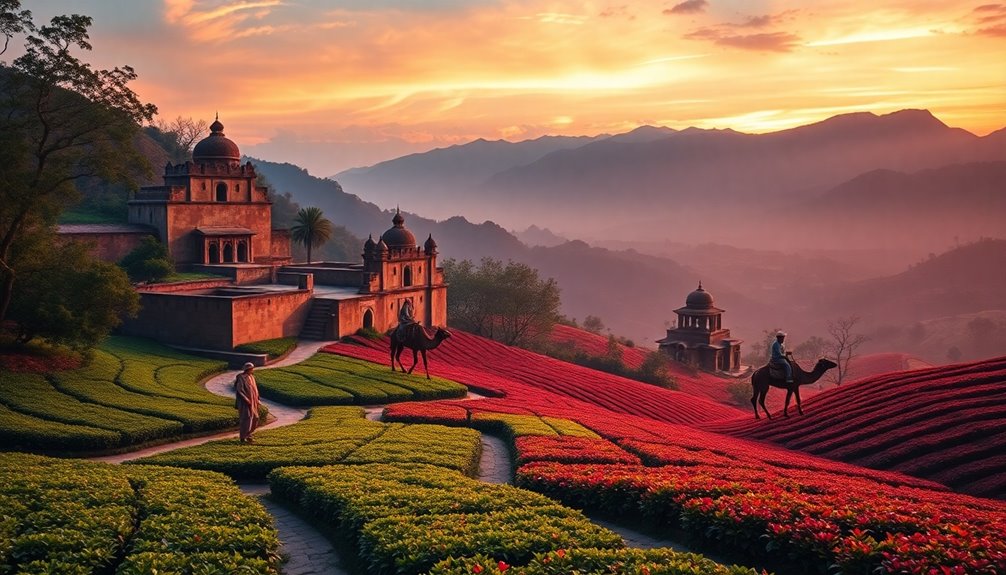
As tea made its way along the Silk Roads, it didn't just bring flavors; it also carried customs and traditions.
People began to embrace tea drinking, and this practice spread across Asia and eventually to the West.
The Tea Horse Road was more than just a trade route; it was a vibrant conduit of culture and commerce that shaped the way we enjoy tea today.
Tea's Journey Through Cultures
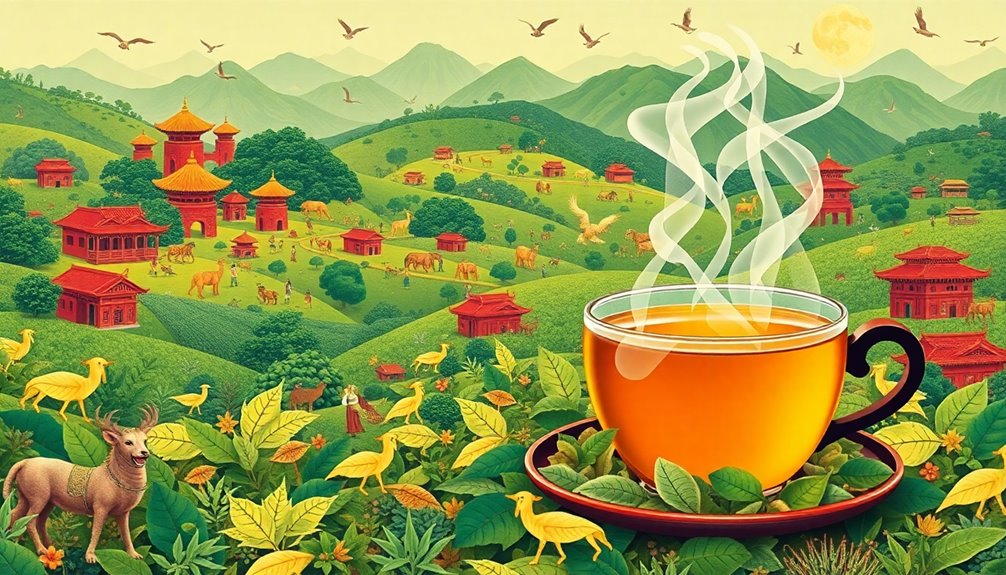
Countless cultures have embraced tea, transforming it from a simple medicinal drink into a cherished ritual. Originating from the *Camellia sinensis* plant, tea first appeared in Yunnan during the Shang Dynasty. By the Han Dynasty, it had become a major trade item along the Silk Road. This trade not only spread tea varieties but also fostered cultural exchanges that shaped how tea was enjoyed worldwide.
During the Tang period, tea shops blossomed in Chang-an, making tea a key part of daily life and hospitality. By the 6th century, Japanese envoys traveled to China, learning about tea culture and integrating it into their Buddhist rituals. Herbal teas, known for their diverse flavors and health benefits, also made their way along these trade routes. The influence of tea on Southern cuisine can be seen in its pairing with dishes like fried catfish during social gatherings. Oolong tea, a notable variety, has been praised for its health benefits and unique flavor profile, making it a popular choice among tea enthusiasts. Moreover, the rise of energy-efficient appliances has encouraged consumers to enjoy their tea while being mindful of their energy consumption.
The Song Dynasty marked a turning point when brick tea transitioned to loose leaf, allowing even more people to enjoy it. The popularity of tea coincided with the rise of wood-burning stoves, enhancing the experience of savoring a warm cup during colder months.
As tea traveled, it adapted to different cultures. For instance, in India, the warming *Kahwa* emerged, flavored with cardamom and spices. Each region added its own twist, showcasing tea's versatility.
Today, tea remains a symbol of connection, celebrating diverse customs and traditions while bringing people together across the globe. So, grab a cup and enjoy the rich journey of tea through cultures!
Lesser-Known Tea-Producing Regions
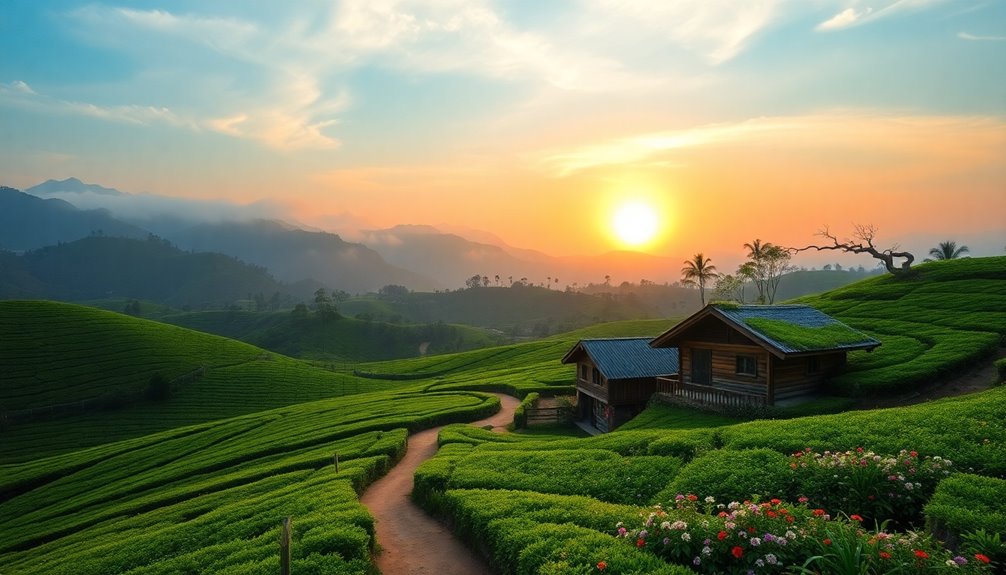
Hidden gems along the Silk Road reveal a rich tapestry of lesser-known tea-producing regions that offer unique flavors and traditions. One such region is Yunnan, home to an ancient tea tree in Jinghong that's over 800 years old! This tree produces Nannuo tea, which is so valuable that it's worth more than its weight in silver.
In Dali, located at a height of 4,500 feet, local artisans perfect the tea fermentation and aging processes, creating teas that are both rich and flavorful.
You can also visit the Hani minority hamlet in Yunnan, where traditional methods like wilting, pan-roasting, and drying are used to craft distinctive teas.
Next, don't miss Shaxi, a historic trade hub along the Tea Horse Road. Here, you'll find bustling tea houses and a market square that reflects the area's vibrant culture, where tea was traded alongside local delicacies and medicinal plants.
Cultural Appropriation of Tea Traditions
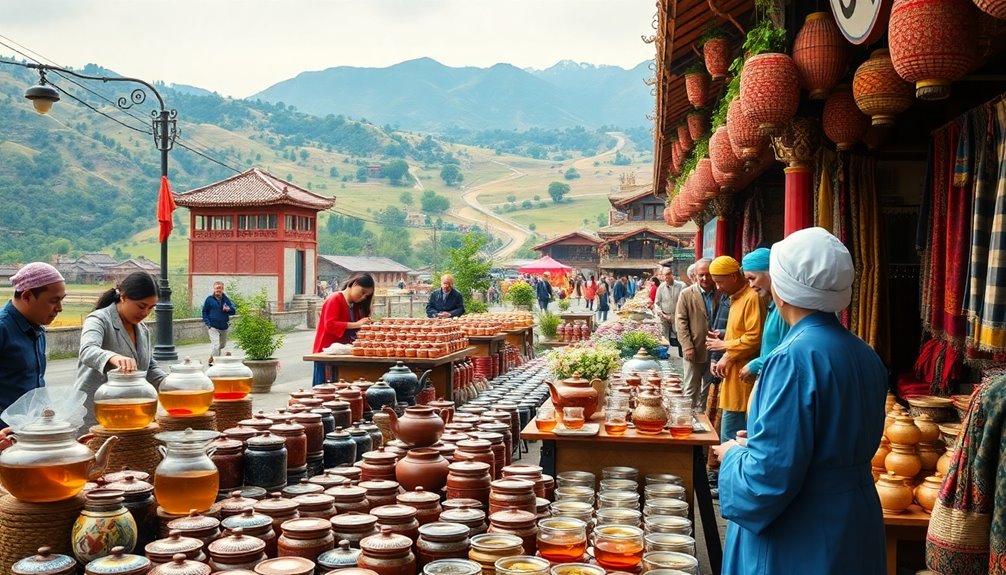
Exploring the rich tapestry of tea traditions along the Silk Road also brings us to a significant issue: the cultural appropriation of these practices. This happens when people from different cultures adopt tea rituals without recognizing their origins, which can dilute their true meanings.
For example, Japan's tea ceremony, known as "chanoyu," is often admired in the West for its beauty. However, many overlook its deep spiritual significance rooted in Chinese traditions.
You might also notice how British afternoon tea blends elements from various cultures, including those of China and India. This blend can sometimes lead to cultural appropriation, as it doesn't honor the historical roots of these practices.
Additionally, the global tea trade has caused the commodification of traditional customs. Often, the authentic ways of preparing and enjoying tea are lost in commercial versions that don't respect their cultural importance.
Cultural appropriation can perpetuate stereotypes and diminish the contributions of the cultures from which these traditions arise.
It's essential to recognize and respect the rich heritage of tea traditions, ensuring that the stories behind each sip are appreciated and celebrated.
Practical Applications
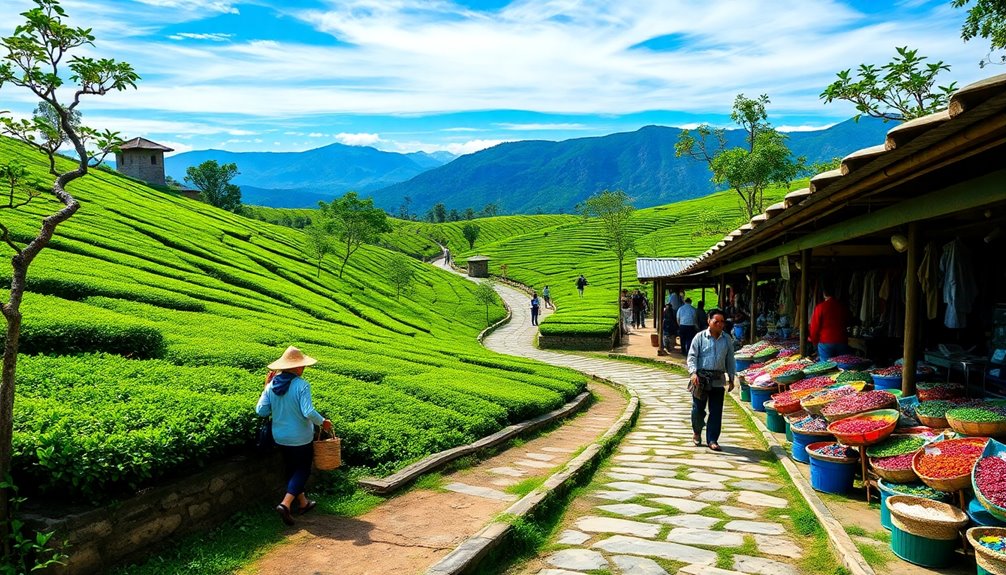
Tea serves as a bridge between cultures and economies, offering practical applications that extend beyond mere enjoyment. The historic Tea Horse Road, a vital route linking the East, played a key role in trading tea and other goods. This 1,850-mile path not only connected Yunnan and Tibet but also influenced local economies and cultures over centuries. The importance of air purification systems in maintaining healthy environments for tea cultivation cannot be understated. Additionally, tea cultivation benefits from glycolic acid, which is known to improve soil health and enhance plant growth. This nurturing environment leads to rich flavors that are highly sought after in the global market. The unique conditions found along the Silk Road contributed to the development of various tea types, which are now celebrated worldwide for their distinct characteristics.
In places like Jinghong, you'll find ancient tea gardens and an 800-year-old tea tree producing Nannuo tea, which is valued as pure gold. This highlights the economic importance of tea cultivation in the region.
Dali, with its towering elevation of 4,500 feet, impacts the fermentation and aging of tea, enhancing its quality and value. The unique climate conditions in this area also contribute to the development of distinct flavors in the tea. Research shows that environmental factors can significantly affect tea quality and taste, making this region particularly renowned.
Modern advancements have made travel along the Tea Horse Road more accessible. What once took over a week can now be done in under four hours!
Plus, in Chengdu, tea houses are everywhere, even outnumbering sunny days. You can enjoy unique experiences like acrobatic tea demonstrations, showing tea's cultural significance today. Recent trends indicate that the ready-to-drink tea segment is expected to reach $20 billion by 2025, reflecting the growing popularity of tea in contemporary culture.
Frequently Asked Questions
Why Was Tea Important on the Silk Road?
Tea was crucial on the Silk Road because it served as a valuable trade commodity, symbolizing luxury. You'd see it exchanged for silk and spices, fostering cultural connections and enhancing diplomatic ties among various regions.
Why Did They Keep the Silk Road a Secret?
You'd find that traders kept the Silk Road's secrets to protect their routes and goods from competitors. By maintaining confidentiality, they safeguarded their economic interests and navigated dangers like bandits and political instability.
Who Bought Tea From the Silk Road?
You'd find traders, merchants, and royalty buying tea, often exchanging it for silk and spices. As demand grew, even common folks in urban centers began enjoying tea, making it a beloved beverage across cultures.
What Was the Ancient Tea Route Southern Silk Road?
The Ancient Tea Route, or Southern Silk Road, is a historic trade network connecting tea regions in China to Tibet and beyond, facilitating the exchange of tea, horses, and cultural influences from the 7th century onwards.
Conclusion
In conclusion, exploring the secret tea trails of the Silk Road is an exciting adventure! You've learned how tea traveled through ancient trade routes, connecting cultures and creating unique traditions. Don't forget to check out those lesser-known tea regions and appreciate their rich histories. So, next time you sip your favorite tea, think about its amazing journey. Share your newfound knowledge with friends, and maybe even host a tea party to celebrate this delicious drink's global story!

